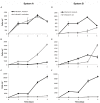A Game of Russian Roulette for a Generalist Dinoflagellate Parasitoid: Host Susceptibility Is the Key to Success
- PMID: 27252688
- PMCID: PMC4878280
- DOI: 10.3389/fmicb.2016.00769
A Game of Russian Roulette for a Generalist Dinoflagellate Parasitoid: Host Susceptibility Is the Key to Success
Abstract
Marine microbial interactions involving eukaryotes and their parasites play an important role in shaping the structure of phytoplankton communities. These interactions may alter population densities of the main host, which in turn may have consequences for the other concurrent species. The effect generalist parasitoids exert on a community is strongly dependent on the degree of host specificity. Parvilucifera sinerae is a generalist parasitoid able to infect a wide range of dinoflagellates, including toxic-bloom-forming species. A density-dependent chemical cue has been identified as the trigger for the activation of the infective stage. Together these traits make Parvilucifera-dinoflagellate hosts a good model to investigate the degree of specificity of a generalist parasitoid, and the potential effects that it could have at the community level. Here, we present for the first time, the strategy by which a generalist dinoflagellate parasitoid seeks out its host and determine whether it exhibits host preferences, highlighting key factors in determining infection. Our results demonstrate that in its infective stage, P. sinerae is able to sense potential hosts, but does not actively select among them. Instead, the parasitoids contact the host at random, governed by the encounter probability rate and once encountered, the chance to penetrate inside the host cell and develop the infection strongly depends on the degree of host susceptibility. As such, their strategy for persistence is more of a game of Russian roulette, where the chance of survival is dependent on the susceptibility of the host. Our study identifies P. sinerae as a potential key player in community ecology, where in mixed dinoflagellate communities consisting of hosts that are highly susceptible to infection, parasitoid preferences may mediate coexistence between host species, reducing the dominance of the superior competitor. Alternatively, it may increase competition, leading to species exclusion. If, however, highly susceptible hosts are absent from the community, the parasitoid population could suffer a dilution effect maintaining a lower parasitoid density. Therefore, both host community structure and host susceptibility will determine infectivity in the field.
Keywords: Parvilucifera; dinoflagellates; host–parasite interactions; perkinsids; prevalence; specificity.
Figures







References
-
- Bai X., Adolf J. E., Bachvaroff T., Place A. R., Coats D. W. (2007). The interplay between host toxins and parasitism by Amoebophrya. Harmful Algae 6 670–678. 10.1016/j.hal.2007.01.003 - DOI
-
- Carpenter E. J., Chang J. (1988). Species-specific phytoplankton growth rates via diel DNA synthesis cycles. 1. Concept of the method. Mar. Ecol. Progr. Ser. 43 105–111. 10.3354/meps043105 - DOI
LinkOut - more resources
Full Text Sources
Other Literature Sources
Research Materials

